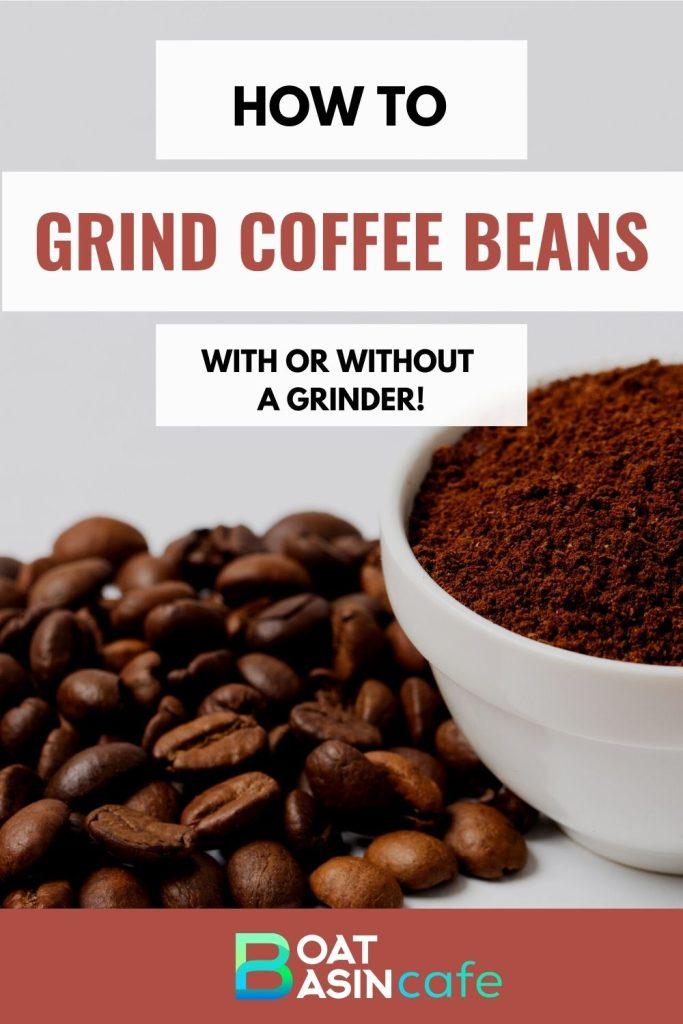The aroma and taste of coffee can lift up anybody’s mood. And if it’s lightly-roasted freshly-ground beans, there is nothing comparable to it.
We all go for easy options like store-bought grounded coffee that taste bland and dull. It’s not that we don’t want to do it at home, the process seems a bit too much to do! Or so we think.
In reality, grinding your own coffee is super easy and much more affordable. You don’t even need a fancy coffee grinder to do that.
In this article, we will explore all the ways there are to grind coffee beans easily at home. We have gathered the easiest methods to answer how to grind coffee beans very efficiently.
The History and Science of Coffee Grinding
Coffee grinding began in Ethiopia in the 15th century. As coffee consumption became widespread, a more effective method was needed to smash coffee beans.
First came the 17th-century coffee grinder. Two crank-operated stones smashed the coffee beans. The metal-roller roller grinder enhanced it.
Steam-powered grinders revolutionised coffee in the 19th century. This mass-produced ground coffee, making it more accessible.
Blade, burr, and electric coffee grinders are available nowadays. Burr grinders smash the beans between abrasive surfaces, whereas blade grinders cut them. The most common grinders are electric.
Coffee grinding science concerns particle size and coffee extraction. Water extracts coffee taste and fragrance faster depending on grind size. Finer grinds extract quicker, whereas coarser grinds extract slower. Choosing the correct grind size for different brewing procedures is crucial.
Overall, coffee grinding has evolved. Technology and knowledge have improved coffee bean grinding. Understanding the coffee grinding process will improve your morning cup, whether you’re a coffee expert or not.
Types of Coffee Grinders
Coffee grinders have been around since the Greeks ruled the world. Not just the Greeks, almost every ancient civilization had some sort of grinders to make a fine powder out of dry herbs and spices. Those versions were manual and took a lot of time and muscle power to use.
Nowadays, we have many different options both manual and electrical. In terms of popularity, there are three main types of coffee grinders:
Blade Grinder:

Blade grinders are the most common and inexpensive type of coffee grinders. They use a blade piece to basically chop the beans into smaller pieces.
When you press the button, the blade starts to rotate at a very fast speed which causes the beans to rotate as well. This motion causes chopping the beans into smaller and smaller pieces.
You can control the grind size by monitoring the amount of time you grind it for. If you want coarse pieces, grind it for 10-15 seconds. For finer pieces, you will need to spend 40-50 seconds. It can be tricky to understand when to stop but after a few tries, you will get the gist of it.
Burr Grinder:
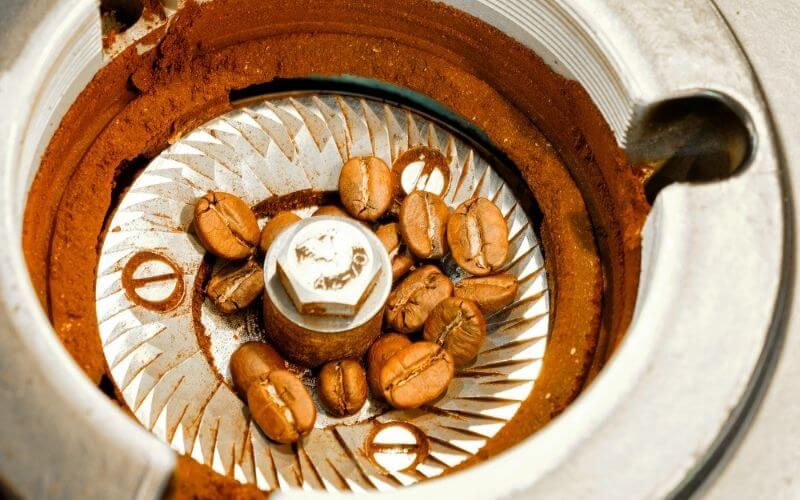
Burr grinders are made using two abrasive surfaces that revolve in a circular motion. The coffee beans fall in between them and get crushed into fine, uniform sizes. Those two abrasive circles are called burr, hence the name.
This is one of the oldest methods of grinding coffee. Even though so many different types of grinders have been invented in the last decade, coffee lovers tend to always favor burr grinders over anything else.
This is because of how uniformed the grounds look when you use them. There are no chunky coffee pieces in the middle of a fine powder. Each time it comes out perfect. Needless to say, it’s our favorite type of coffee grinder as well.
Manual Grinder:
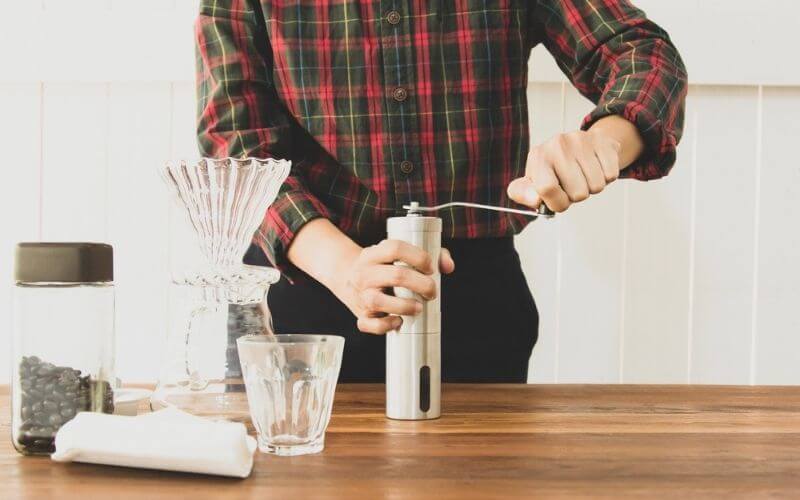
Most burr grinders are electrically powered which makes them super easy to use. But there are still some manual options available.
Manual grinders are great as you can carry them anywhere with you. So if you plan to travel a lot or go camping, you can take your manual grinder. It requires no power or fuel which is economical and environmentally friendly.
They also look vintage and stylish. Old-fashioned things have a certain charm that makes anything feel very luxurious and elegant. Manual grinders look very attractive compared to our modern electrical options.
The Different Brewing Methods
To achieve the best results, different brewing methods necessitate different grind sizes, and a grind size that is too fine or too coarse can affect the taste and quality of the coffee.
Understanding the various brewing methods and how to select the appropriate grind size can assist you in making the perfect cup of coffee.
| Brewing Method | Grind Size | Coffee Taste and Quality |
|---|---|---|
| Drip Coffee | Medium to fine grind | Well-balanced, smooth, flavorful |
| French Press | Coarse grind | Full-bodied, rich flavor |
| Pour-Over | Medium grind | Clean, crisp |
| Espresso | Very fine grind | Strong, bold |
Coffee Beans Grinder Machine: How to Use
We have gathered all the different ways there are to grind your coffee beans using many different instruments. You will also find how to grind coffee beans without a grinder.
Grinding Coffee Beans in Vitamix:

Vitamix is one of the most reliable and well-known blenders/grinders. Due to its high-efficiency, it has become a household name for many.
They claim that your Vitamix can blend everything. But can it grind coffee grinds though?
We tried and discovered it is really good for grinding coffee beans! Of course, it’s not going to perform like a proper coffee grinder!
The ground coffee from a Vitamix is not as precise or consistent. So you can get a mixture of smooth and coarse ground beans. However, for an easy, quick option, it’s comparable to basic, low-end coffee grinders on the market.
Here is how to grind coffee beans in a Vitamix:
- Use the dry blade container to get better results. Start by measuring out 2 cups of roasted coffee beans.
- Check the user manual to find out the best settings for grinding. Set the left switch to “variable” and turn the dial to number 3. This setting varies depending on which model of Vitamix you have.
- Add the beans to the container and close the lid.
- Turn on the machine and let it grind for 15 seconds. This is enough for any standard drip coffee. The longer you do it, the finer the grind will be. Finer grind is ideal for Turkish style coffee or espresso.
- Grind for 5 seconds and take a break. Shake the container if necessary. This helps to create a more uniform blend.
Nutribullet Coffee Grinder:
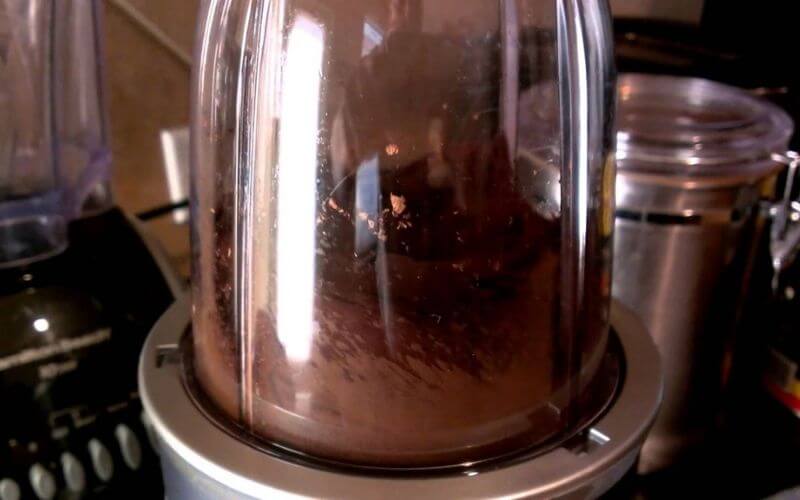
Nutribullet is known for its versatile functionality and convenient design. You can use it for a wide variety of items including coffee beans.
This is probably the easiest way to grind your coffee beans. Here’s how to grind coffee beans in a Nutribullet coffee grinder:
- Always check the manual as the first step. If there are any instructions, follow that.
- Use the flat blade for coffee beans. Fill up the container with as many beans as you need. We would recommend keeping a little bit of space inside.
- Start the blender and let it grind for 10 seconds without interruptions.
- Shake the container and grind again for 5 minutes. Keep doing this until you’re satisfied with the blend.
- Shaking it helps to help the large particles go down toward the blade.
- Unplug your Nutribullet and put the ground beans into an airtight container. This is perfect for easy morning coffee. And it takes less than a minute to do so!
Grinding Coffee Beans in a Blender:
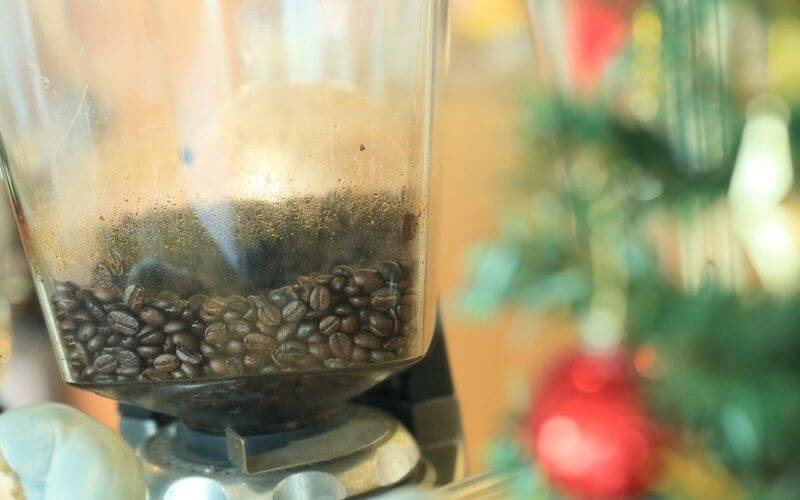
If you have no kitchen appliances, chances are you have a basic blender and a microwave. We all do. That’s why it makes sense to use one for coffee beans.
But the process is not as simple as just tossing them inside and pressing a button. Here’s how to grind coffee beans with a blender:
- Check if your blender has a “grinder” setting. If it has one, select it. If not, look for the “medium-high” setting.
- Pour around ½ cup of beans into the blender and close the lid firmly.
- Use the pulse setting to grind your beans. Grind them for 5 seconds and then take 3 seconds to break. Then grind again for 5 seconds.
- Repeat this at least 7-8 times. You should grind for a total of 30 seconds. To make sure it’s grinding consistently, tilt the blender sideways in the middle of grinding.
- Pour it all into an airtight container to store it for longer.
Ninja Blender Coffee Grinder:
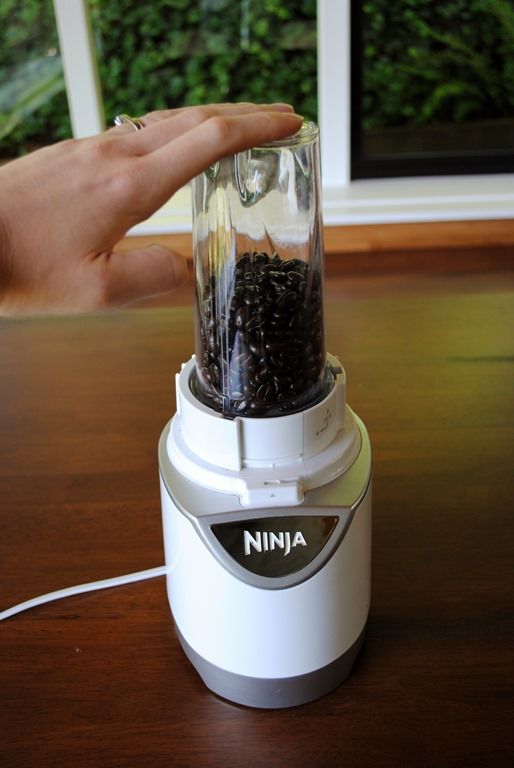
Ninja Blender is a very known kitchen appliance used by millions of people. They have a wide range of models. For this particular task, having a single-serve cup is the most preferable.
So here’s how to grind coffee beans with a Ninja blender:
- It’s important to clean up your ninja blender very well. If you previously used it for spices or garlic, then it would have a strong scent that can ruin the smell of the coffee.
- Put a cup of coffee beans on your Ninja Blender or until there is 3 inches empty space left on the container.
- Plugin your blender and pulse up to 8-10 times depending on the texture you want. If you want it coarse, pulse less. For finer ground, you can pulse up to 12 times.
- And that’s about it. Your coffee is ready to brew!
How to Grind Coffee Beans without a Grinder/Blender
If you don’t have a grinder or a blender, there are still ways to grind your coffee beans to desired consistency. We will tell you how to grind coffee beans for espresso without any electronic kitchen gadgets.
These steps might need some elbow grease and patience to follow as some of them are not as simple as pressing a button!
Rolling Pin:
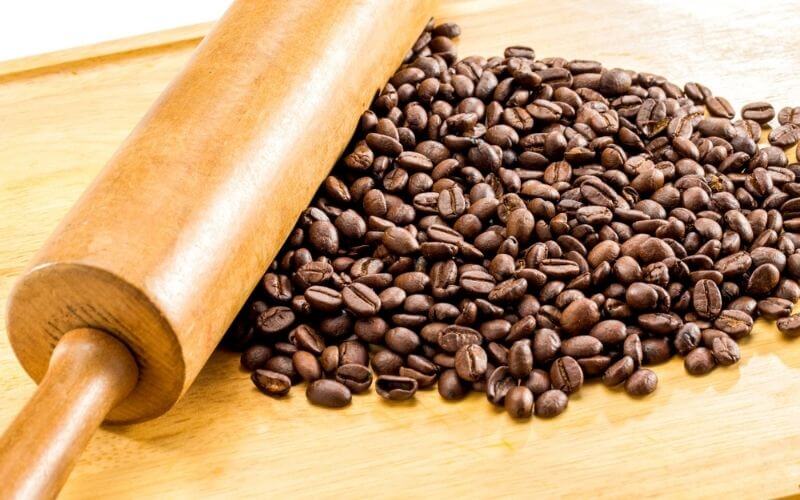
You might not think about it, but a rolling pin is a very easy way to make coarse grind without any machine. All you need is a ziploc bag and of course, a rolling pin, and you are set for grinding your own coffee.
Even though it’s pretty self-explanatory, here’s how you can grind your coffee beans using a rolling pin:
- Put your desired amount of roasted coffee beans in a ziploc bag. It is ideal to not overfill the bag. Less is more for this process.
- Grab your rolling pin and gently press all over the bag. This will lightly crush the beans. Sue your rolling pin like a hammer for this step.
- Now start to drive the rolling pin front and back applying light pressure. Keep doing it until all the beans are evenly crushed.
- Move around the larger pieces to the middle and repeat the process. This can take a bit of time but be patient with it.
Mortar and Pestle:

We don’t recommend using this method for larger batches as mortar and pestle is quite labor-intensive. But if you are trying to grind coffee for only 1-2 cups, this is very useful.
For finer ground, mortar and pestle is ideal. You can also control how coarse or how fine you want your beans to grind.
Here’s how to use mortar and pestle for coffee beans:
- Use around ¼ cup of coffee beans to fill up your mortar. This obviously depends on how big the mortar is. Ideally, you should always have enough space left to move the pestle around.
- Hold the pestle with your dominating hand and put the other one on the pestle to make sure it doesn’t move. For a stone pestle, you might not need to do that as they are quite heavy.
- Force the pestle down and use it as a hammer to break the beans into tiny pieces.
- When all the beans are crushes, move the pestle in a circular motion so the beans start to grind into a finer consistency. Keep doing it until you reach your desired level.
- Use a spoon to move around the beans so no part of it can escape the grinding motion of the pestle.
- When you are done, remove the grounds and repeat from step 1 for more coffee.
Troubleshooting Tips
Grinder Not Grinding Beans
If you find that your coffee grinder is not grinding beans, it could be due to several reasons. The first thing you should check is the power source. Make sure the grinder is plugged in and the power source is working. If the grinder is working but not grinding beans, check the blades. They may be dull or broken and need replacement. Another cause could be an accumulation of coffee oils and residue that clogs the grinder. Cleaning the grinder with a brush or a dry towel can help remove this buildup.
Uneven Grinding
Uneven grinding can occur if the grinder blades are dull or unevenly worn. It could also be a result of too many or too few beans in the grinder. If you are experiencing uneven grinding, check the blades and ensure they are sharp and evenly spaced. Also, make sure that you are using the correct amount of coffee beans for the desired consistency. Overloading or underloading the grinder can lead to uneven grinding.
Grinder Jamming
Grinder jamming is a common problem that can occur when beans get stuck in the grinder. If you are experiencing jamming, try cleaning the grinder and blades thoroughly to remove any blockages. If this does not solve the problem, check for any damaged or bent parts that may need replacement.
Coffee Grounds Clumping Together
Coffee grounds clumping together can be a result of static electricity. To reduce static, try using a different container or cup to catch the coffee grounds. You can also try adding a small amount of salt to the coffee beans before grinding. Another solution is to use a grinder with an antistatic coating.
Inconsistent Grind Size
Inconsistent grind size can be caused by various factors, including dull or unevenly spaced blades, too many or too few beans in the grinder, or an incorrect grind setting. If you are experiencing inconsistent grind size, try adjusting the blades, using the correct amount of beans, or changing the grind setting.
FAQs
01. Is Grinding Coffee Beans Worth It?
If you are a passionate coffee drinker, you have to grind your own coffee beans. Not only does it taste hundreds of times better than pre-ground coffee, but it also has a better aroma. There is nothing nicer than the smell of freshly-ground coffee beans.
Pre-ground coffee beans lose a lot of natural oil and moisture in the process. This results in a dull, bland brew that does not feel very strong. With your own ground coffee, you won’t need as much to get the same kick. It’s very economical as well!
02. Does a Finer Grind Make Stronger Coffee?
The size of your grinding does not dictate how strong or weak your coffee will taste. The ground size matters in terms of brewing time.
If your coffee ground is coarse, it would take longer to brew in comparison to if it were fine powder. But finer grind does help to bring out the aroma and natural oil from within. This makes your coffee taste better and balanced.
However, if you overdo it, your coffee will taste very bitter and unpleasant.
03. How Many Coffee Beans Should I Grind?
This totally depends on how much coffee you want to make. You can batch grind a lot of them to store ro you can just grind every day to get the freshest brew possible.
Passionate coffee enthusiasts will tell you to grind coffee beans every day. And why not? You will only have to use 2 tablespoons of coffee beans to make 2 cups.
It’s so little that it takes literally seconds to do! But the result is a refreshingly strong coffee each time.
As it was freshly grounded, all the flavors stay inside it rather than evaporating in the air. So the aroma is stronger and smoother than store-bought ones.
You can also take a cup of beans to grind them for batch storing. A cup of coffee beans will make around 10 oz of ground coffee.
Inference
We tried to add a wide range of ways to grind your coffee beans at home. Hopefully one of them suited your needs and preferences. Now you know exactly how to grind coffee beans at home both with or without a grinder!
Which one are you going to try? Let us know in the comments down below!
Pin Later
